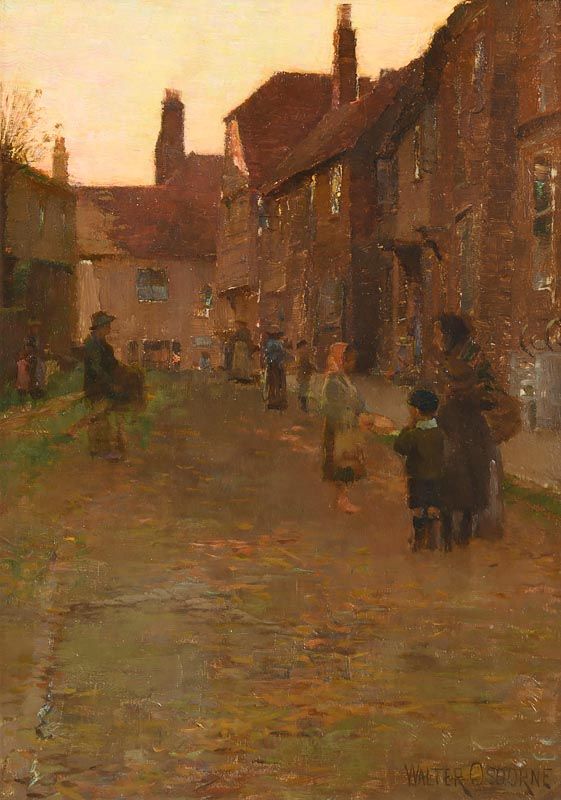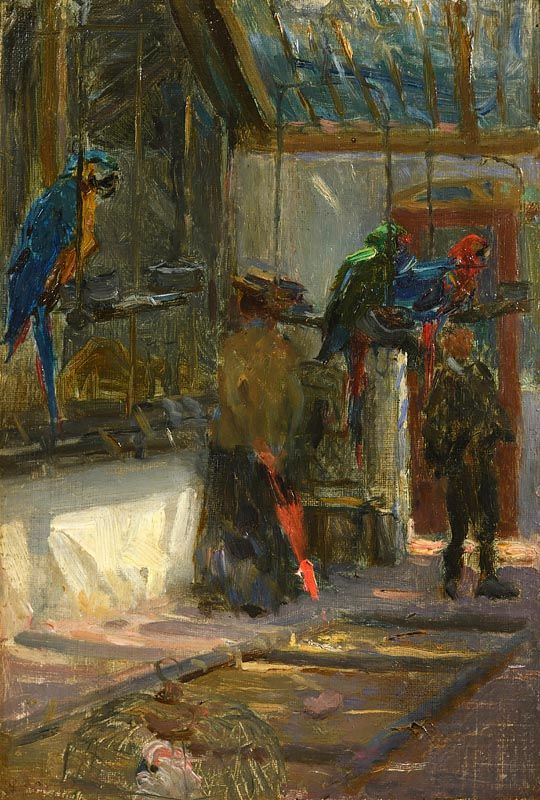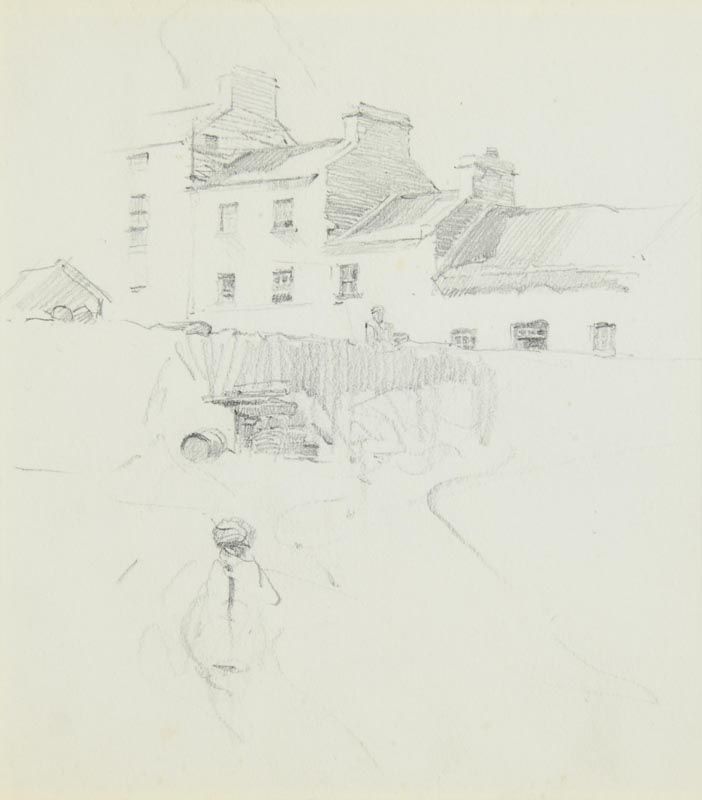Walter Frederick Osborne RHA (1859 - 1903) Early Morning in the Markets, Quimperlé (1883) Oil on canvas 40.6 x 31.8cm (16 x 12 ½ “) Signed, inscribed and dated 1883 Provenance: By descent from the owner’s great grandmother, who was a friend of the painter. Exhibited: Dublin, Royal Hibernian Academy, 1884, cat no 256; Dublin, National Gallery of Ireland, The Irish Impressionists, Irish Artists in France and Belgium, 1850 – 1914, Oct/Nov 1984, cat no 69; Belfast, The Ulster Museum, The Irish Impressionists, Irish Artists in France and Belgium, 1850 – 1914, Feb/Mar 1985, cat no 69. Limerick, The Hunt Museum, Lavery and Osborne: Observing Life, May 2019 Literature: Jeanne Sheehy, Walter Osborne, Ballycotton 1974, no 71; J. Sheehy, ‘Walter Osborne in Quimper (sic) and Pont Aven, 1883’, in Old Limerick Journal, vol.25, summer 1989, p.28, illustrated; K. McConkey, ‘Early Morning in the Markets’ in ‘Lavery & Osborne, Observing Life’, 2019, p.84-85, illustrated; Dr Julian Campbell, The Irish Impressionists, Irish Artists in France and Belgium, 1850 – 1914, NGI, p.212 Early Morning in the Markets, Quimperlé is an attractive Continental street scene such as Walter Osborne loved to paint. It shows several Breton figures at a small market, with a colourful display of vegetables, in Quimperlé on a sunny day. After completing his studies in Antwerp in 1883 Osborne headed south west to Brittany to paint ‘en plein air’. He worked in Dinan, Pont Aven and at Quimperlé, often together with fellow former students from Ireland and England. Early Morning in the Markets, Quimperlé, set in the lower part of Quimperlé, is a companion piece to Osborne’s best-known Breton painting Apple Gathering, Quimperlé, 1883, (NGI), set in the upper town, both pictures featuring a church, and both being inscribed ‘Quimperlé’. Quimperlé had developed around the confluence of the rivers Elle and Isole, which combined to form the river Laita. The church of Ste-Croix was founded in the 12th century, based on the plan of the Holy Sepulchre of Jerusalem. It was famous for its magnificent apse, and became one of the most important spiritual centres in Brittany.(1) In the upper part of the town, the church of St Michel, Notre Dame de l’Assomption dated from the 13th and 15th centuries. Quimperlé was a peaceful Finistère town, with a wooded river valley, apple orchards and mild climate, narrow streets cutting down to the lower quarter, bridges, and old houses with gardens by the river. The arrival of the railway line in 1862 made the town much more accessible to visitors. The establishment of schools in the 1870s and 1880s encouraged the education of local girls and boys. (2) Although less well-known as an artist’s colony than Pont-Aven and Concarneau, Quimperlé had a thriving community of British and Irish painters there from the 1880s to the early 20th century, notably Stanhope Forbes, Henry La Thangue, George Clausen Osborne, J.M.Kavanagh, Blandford Fletcher Charlotte Benson and Norman Garstin as well as Norwegian Fritz Thalow.(3) Forbes had moved to tranquil Quimperlé because Pont-Aven and Concarneau had become too crowded, and because studios were cheap. It is possible that Osborne may have done so for the same reasons. Early Morning in the Markets, Quimperlé features several figures: a girl and elderly woman, a boy, a woman shopping and a stall holder. The cheerful whites and blues of the Breton costumes and the green canopy in sunlight attract our attention. In the foreground a young girl and woman are seated behind a colourful array of vegetables, waiting for customers. The cheerful rosy-cheeked child contrasts with the elderly woman, whose headdress casts a shadow on her face. The woman at the stall with white bonnet and collar, faded garments and shopping basket, viewed from behind, is an archetypical Breton figure by Osborne. To her right is a boy in dark Breton hat, face in profile, and smock. Behind them the market woman stands under the green sunlit canopy;
Walter Frederick Osborne RHA (1859 - 1903) Early Morning in the Markets, Quimperlé (1883) Oil on canvas 40.6 x 31.8cm (16 x 12 ½ “) Signed, inscribed and dated 1883 Provenance: By descent from the owner’s great grandmother, who was a friend of the painter. Exhibited: Dublin, Royal Hibernian Academy, 1884, cat no 256; Dublin, National Gallery of Ireland, The Irish Impressionists, Irish Artists in France and Belgium, 1850 – 1914, Oct/Nov 1984, cat no 69; Belfast, The Ulster Museum, The Irish Impressionists, Irish Artists in France and Belgium, 1850 – 1914, Feb/Mar 1985, cat no 69. Limerick, The Hunt Museum, Lavery and Osborne: Observing Life, May 2019 Literature: Jeanne Sheehy, Walter Osborne, Ballycotton 1974, no 71; J. Sheehy, ‘Walter Osborne in Quimper (sic) and Pont Aven, 1883’, in Old Limerick Journal, vol.25, summer 1989, p.28, illustrated; K. McConkey, ‘Early Morning in the Markets’ in ‘Lavery & Osborne, Observing Life’, 2019, p.84-85, illustrated; Dr Julian Campbell, The Irish Impressionists, Irish Artists in France and Belgium, 1850 – 1914, NGI, p.212 Early Morning in the Markets, Quimperlé is an attractive Continental street scene such as Walter Osborne loved to paint. It shows several Breton figures at a small market, with a colourful display of vegetables, in Quimperlé on a sunny day. After completing his studies in Antwerp in 1883 Osborne headed south west to Brittany to paint ‘en plein air’. He worked in Dinan, Pont Aven and at Quimperlé, often together with fellow former students from Ireland and England. Early Morning in the Markets, Quimperlé, set in the lower part of Quimperlé, is a companion piece to Osborne’s best-known Breton painting Apple Gathering, Quimperlé, 1883, (NGI), set in the upper town, both pictures featuring a church, and both being inscribed ‘Quimperlé’. Quimperlé had developed around the confluence of the rivers Elle and Isole, which combined to form the river Laita. The church of Ste-Croix was founded in the 12th century, based on the plan of the Holy Sepulchre of Jerusalem. It was famous for its magnificent apse, and became one of the most important spiritual centres in Brittany.(1) In the upper part of the town, the church of St Michel, Notre Dame de l’Assomption dated from the 13th and 15th centuries. Quimperlé was a peaceful Finistère town, with a wooded river valley, apple orchards and mild climate, narrow streets cutting down to the lower quarter, bridges, and old houses with gardens by the river. The arrival of the railway line in 1862 made the town much more accessible to visitors. The establishment of schools in the 1870s and 1880s encouraged the education of local girls and boys. (2) Although less well-known as an artist’s colony than Pont-Aven and Concarneau, Quimperlé had a thriving community of British and Irish painters there from the 1880s to the early 20th century, notably Stanhope Forbes, Henry La Thangue, George Clausen Osborne, J.M.Kavanagh, Blandford Fletcher Charlotte Benson and Norman Garstin as well as Norwegian Fritz Thalow.(3) Forbes had moved to tranquil Quimperlé because Pont-Aven and Concarneau had become too crowded, and because studios were cheap. It is possible that Osborne may have done so for the same reasons. Early Morning in the Markets, Quimperlé features several figures: a girl and elderly woman, a boy, a woman shopping and a stall holder. The cheerful whites and blues of the Breton costumes and the green canopy in sunlight attract our attention. In the foreground a young girl and woman are seated behind a colourful array of vegetables, waiting for customers. The cheerful rosy-cheeked child contrasts with the elderly woman, whose headdress casts a shadow on her face. The woman at the stall with white bonnet and collar, faded garments and shopping basket, viewed from behind, is an archetypical Breton figure by Osborne. To her right is a boy in dark Breton hat, face in profile, and smock. Behind them the market woman stands under the green sunlit canopy;









-lg.jpg)





Try LotSearch and its premium features for 7 days - without any costs!
Be notified automatically about new items in upcoming auctions.
Create an alert